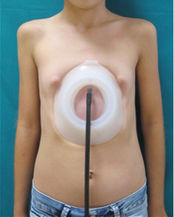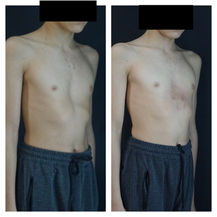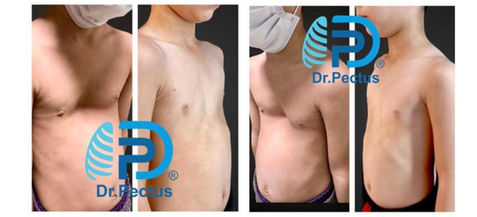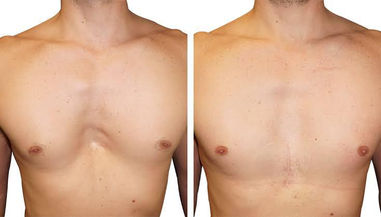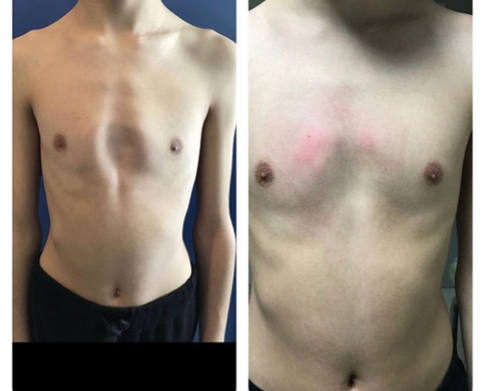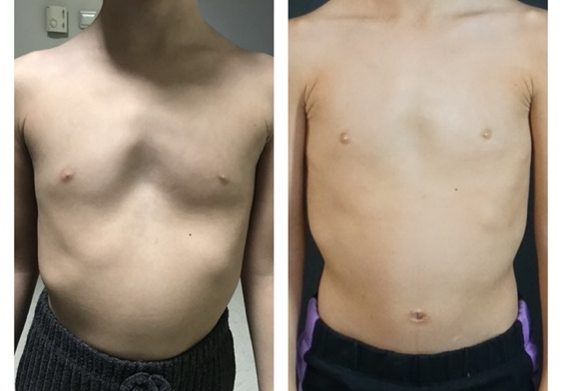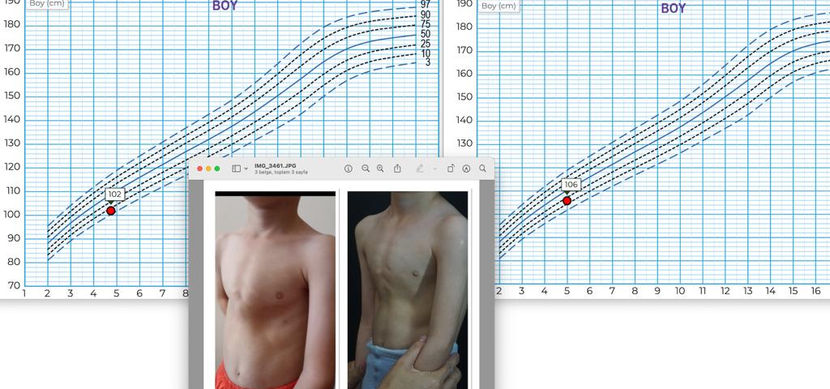
Chest Wall Deformities

Pectus Excavatum
What is Pectus Excavatum?
Pectus Excavatum is also known also known as funnel chest or sunken chest. It is the inward collapse of the rib cage.
Pectus Excavatum is the most common type of chest wall deformity seen at a rate of one in 300 to 400 live births. It is not as rare as it is thought. Children with this deformity have very typical appearance: Narrow and thin chest, hooked shoulders, concave ribs and poor posture. Pectus excavatum that usually develops at birth or in the first years of life is noticed by the mother and relatives. Although it regresses very rarely, the collapse is likely to get worse during puberty. For this reason, the most common age to consult a doctor is adolescence period. It is 4 times more common in men than in women. The cause of the collapse is known to excessive growth of the cartilage ribs, but the etiology is not known exactly. Unevenly growing cartilage pushes the rib sternum backward. An increased familial predisposition exists. Of patients, 37% have a family history of similar chest deformity(ies).
This deformity is often tolerated in childhood. The most common symptom is impaired effort tolerance. Exercise dystolerance should not be considered as patients returning home from school or work tired all day long. Exercise dystolerance is actually a sudden feeling of tiredness and breathlessness during exertion. For example, while children of similar height and weight in the same age group can run up 5 flights of stairs without any problems, a child with pectus excavatum may be cut off from running on the third floor. Deformed cartilages can cause pain in the ribs and left breast area after exertion. Palpitations and irregular heartbeats (arrhythmias) can also be observed after exertion. A heart murmur can be heard after a short exercise. Electrocardiographic changes may occur due to dislocation of the heart. When the deformity of the chest wall is corrected, improved lung and cardiac functions are observed.
Dislocation of the chest wall backward causes a sunk, especially on the anterior wall of the right ventricle of the heart. With the correction of its collapse, the sunk of the heart ventricle is corrected, as well. In the simplest terms, the collapse steals, as much as its volume, from the volume of the heart and lungs. In my own words, I always warn patients that “this deformity causes problems in old age, not in youth” This is because in old age, the stolen volumes of the heart and lungs due to deformity will be needed more in old age. In addition, postural disorders due to deformity will cause symptoms such as pain and limitation of movements in old age.
For respiratory and heart-related problems, the more pre-treatment collapse present, the more recovery should be expected. Many researchers have attributed the symptomatic deformity in pectus excavatum to a decrease in the volume of the chest cavity. It is difficult to prove the presence of this relationship because there is a wide range of cardiopulmonary function limits even in normal individuals. This totally depends on physical activity and body habits.An individual with pectus excavatum can also overcome many sports branches by forcing himself, build a beautiful body with bodybuilding, and become a swimmer. There are many examples of this in the world. However, it is certain that it will be beneficial to treat this deformity in order to do this sport more easily, to have a better body shape and to be more successful in the sport.
Would you like to see how the pectus deformity looks at the heart from the inside with surgical images?
Attention! The video may contain surgical footage. In this regard, we recommend that it not be watched next to sensitive individuals and children.
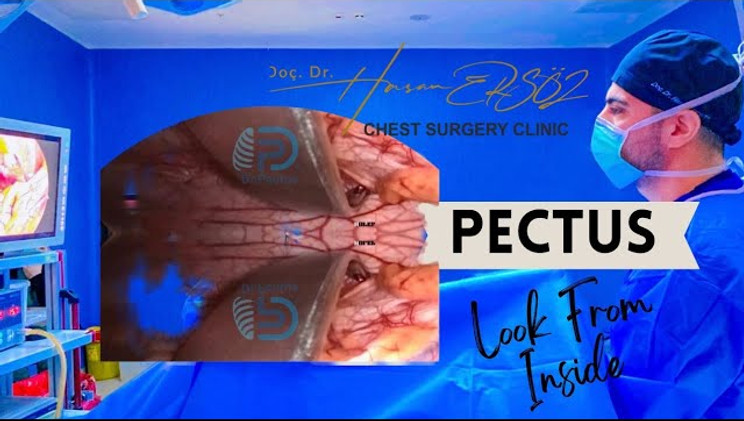
Pectus excavatum does not only affect the heart and lungs. Due to the pressure of the esophagus and stomach, it can cause the patients to feel full and hungry quickly, and this can cause the children not to be fed enough. You may find that most children with Funnel Chest remain underweight. The diaphragm is another organ whose function deteriorates under pressure. Diaphragm functions cannot be fully fulfilled in individuals with pectus excavatum. As a result, the breathing capacity of the patients, especially in the supine position, decreases. In daily life, this situation may occur with poor sleep quality. Sleep quality has been shown to be low in individuals with pectus excavatum. It is a well-known fact that individuals who sleep with low sleep quality for a long time will be more prone to heart attacks after a certain age.
In addition, if the patient is unhappy with this deformity, this alone creates a need for correction, even if it causes no dysfunction. The literature accepts this in this way. There are many patients expressing their unhappiness by saying that they have never swum in the sea without their T-shirt. Psychiatrists have conducted a high number of studies on this issue since 1960, and have used the term “mental deformity” for this condition. A study found problems such as anxiety, motivation disorder, labeling anxiety (82%), lack of self-confidence and timidity (78%), indecision (72%), and aggression (66%).
Treatments of Pectus Excavatum
There are surgical and non-surgical treatment options for chest collapse.
For more info view our Treatments

Pectus Carinatum
What is Pectus Carinatum?
Deformities in which the chest wall is not sunken inward but protrudes outward, are called pectus carinatum deformity. This deformity is rarer than pectus excavatum. It usually does not cause a decrease in heart or lung functions. This treatment is primary need due to the patient’s unhappiness with his/her appearance.
Treatment of Pectus Carinatum
Pectus Cariantum treatment is surgical, just like that of pectus excavatum deformity. Similarly, a steel bar placed under the skin with the minimally invasive - MIRPC procedure (Abramson Procedure) can collapse the chest wall and bring it to its normal position or sternum bone is disconnected from the cartilage by making a big incision with the Ravitch procedure and the cartilage can be shortened if necessary. The difference of the Abramson procedure from the Nuss procedure performed for patients with pectus excavatum is that it does not access the chest cavity, and the bar is transported over the bone. Therefore, serious complications such as heart injuries are not observed.
The use of orthoses comes to the forefront in non-surgical treatment. The deformity is improved by applying constant pressure to the protruding area with an orthosis, while allowing for the development of the other parts. For orthotic treatment, there are treatment approaches that include 23 hours, 18 hours, 12 hours or 6 hours of application per day. The longer the daily application period involved by the approach, the sooner the results can be obtained. However, this depends on the patient's social life. It would be appropriate to perform the procedure in an experienced medical center, where this procedure has been performed in a large number of cases, in order to be able to select the appropriate orthosis, to ensure that the orthosis has been produced of a suitable material, to prevent potential development of Pectus Excavatum during the use of the orthosis, and to closely monitor the patient properly. Patients should be monitored at certain intervals, in order to determine how long the treatment should be continued, when it should be paused until the the bones harden, and when it can be repeated.
In the selection good candidates for orthotic treatment, it is necessary to make sure that the chest wall has yet to harden. Therefore, it is applied to patients under 17 years of age. Measurement should be made to see under how much pressure the patients' deformities improve, and a surgical procedure should be chosen without applying an orthosis for patients who need a pressure above a certain value. In addition, if the pressure required for correction decreases compared to the pressure measured in the previous inspection even if the images of the patient do not show improvement during the control examinations, it means that the treatment of the patient is on the right track and visual results will also be obtained by continuing the treatment. This prevents unnecessarily quitting the treatment.

Pectus Arcuatum
Pectus Arcuatum can be roughly considered as a deformity where both pectus carinatum and excavatum are present together. To better comprehend Pectus Arcuatum, it's necessary to have a basic understanding of the anatomy of the normal sternum.
The sternum bone consists of three parts. The uppermost part is called the manubrium, the middle part is the corpus, and the lower part is the xiphoid. These three pieces are connected by immovable joints. However, these parts are not straight but slightly convexly articulated, protruding slightly outward. Therefore, when viewed from the side, the sternum bone shows the classic "banana shape." An ideal chest cage shape should have this "banana shape." The angle between the manubrium and the corpus is referred to as the "angle of Louis" in anatomy. An angle of 162 degrees is considered ideal.

In pectus excavatum or carinatum deformities, the body and xiphoid part of the sternum are usually located more inward or outward than they should be. In Pectus Arcuatum deformity, the manubrium part and the adjacent cartilaginous ribs protrude excessively outward. Not only is there protrusion of the manubrium, but also the Louis angle, which should ideally be 162 degrees, has significantly decreased, forming a sharp corner on the bone and causing the body and tail portion of the bone to be oriented further inward than it should be.

So, as we mentioned at the beginning, it can be considered as a form of deformity where both pectus carinatum and excavatum are observed together. However, Pectus Arcuatum constitutes less than 1% of pectus deformities.

Treatment of Pectus Arcuatum
As a matter of literature knowledge, there is no non-surgical treatment for Pectus Arcuatum. However, since this surgery is not performed before the completion of the growth and development of children, for Pectus Arcuatum deformities detected at a young age, instead of waiting for the child to grow without doing anything, we provide patients with the opportunity for non-surgical correction until they reach adulthood. We have many patients who have benefited from our efforts in this regard.
At Dr. Pectus Clinic, we offer a non-surgical treatment option using both orthotics and vacuum. Typically, the protrusion that is pointed outwards is too rigid to be suppressed by an orthosis. However, our goal is to stop the bone from growing in that direction by applying pressure with the orthosis, allowing the parts not in contact with the orthosis to continue growing. Additionally, we aim to encourage the inwardly depressed part to grow outward by the pulling effect of the vacuum.
By utilizing the ongoing growth and development of the child, we leverage this advantage. As we do not expect immediate results solely from the pressure of the orthosis or the pulling force of the vacuum, this treatment takes a longer period of time (years) to yield results compared to non-surgical treatments we apply for pectus excavatum or carinatum.
The defined surgical treatments for Pectus Arcuatum in the literature are the Ravitch method and the Önen Method, which we have introduced to the literature.
You can refer to the relevant sections for details.
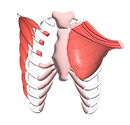
Poland's Syndrome
Poland's Syndrome is quite rare compared to pectus excavatum and carinatum deformities. The signs and symptoms seen in those who have this syndrome:
• Breast tissue or the nipple is small or absent
• The chest wall muscles on the affected side are underdeveloped or absent
• Subcutaneous adipose tissue is underdeveloped
• There is no axillary hair on the affected side
• There is a thoracic deformity due to the absence or underdevelopment of the ribs
• The arm or forearm on the affected side is short, hand fingers are short (brachydactyly) and there is finger fusion (syndactyly)
One or more of these signs and symptoms may be observed.
For the treatment of Poland Syndrome Click Here.

Sternal Cleft
The sternum bone is formed by the connection of two leaves in the middle. In cases where this connection is absent due to a developmental disorder in the embryonic period, the Sternal Cleft (Cleft) is observed. A sternum can be in the form of a complete cleft, or a partial cleft, depending on the point at which the fusion ends.
For the treatment of Sternal Cleft Click Here.

Rib Flare (Protruding Rib)
Rib Flare (Protruding Rib) is the condition in which the ribs protrude. In this type of deformity, the patient complains a lot about his/her appearance. In the past, rib removal surgery used to be performed in all cases.
Today, bandage treatment is also performed in addition to surgical interventions for the treatment of these deformities.
For the treatment of Rib Flare with Bandage Treatment Click Here.
For the treatment of Rib Flare with Cartilage Rib Removal Click Here.

Thoracic Dystrophies
It is a condition of shrinking in the chest cage. It can affect multiple organs. It can be acquired after a previous chest cage surgery or can be congenital. The congenital form is genetically inherited. It can lead to inadequate development of lung and chest organs causing respiratory distress in the form of "Asphyxiating Thoracic Dystrophy," or it can manifest as "Fibrodysplasia Ossificans," causing issues in toe and chest wall bones. The form often seen as "Asphyxiating Thoracic Dystrophy" has 22 different types. The most commonly known is "Jeune Syndrome." Other well-known ones are Saldino-Noonan Syndrome, Majewski Syndrome, Mainzer-Saldino Syndrome, Beemer-Langer Syndrome, and Ellis-van Creveld Syndrome. The common findings in all phenotypes are inadequate development of the chest cage (thoracic hypoplasia) and shortened ribs, which can lead to various deformities in the chest wall.
Due to inadequate development of the chest cage, the lungs, heart, and other chest organs cannot grow properly. In growing children, the heart and lungs that fail to grow might not meet the body's needs and can become life-threatening. These children are also prone to frequent lung infections, and some of them may be lost due to these reasons. Therefore, applying definitive treatment to children over the age of 1 is crucial.
Conditions Accompanied by Various Syndromes
Achondroplasia
Achondroplasia is a genetically inherited cartilage development disorder. It causes a reduction in the rib cage at a rate of 35-53%. Compared to individuals of average height, the chest circumference was reduced by 25-30%. Especially in men, while the horizontal diameter is closer to normal, the anterior posterior diameter is considerably smaller.
Noonan Syndrome
Noon Syndrome is characterized by short stature and congenital heart disease. It is genetically inherited. It occurs equally in men and women. It has components that affect many organs. The skeletal component includes chest wall deformities and pectus excavatum.
Osteogenesis Imperfecta
This genetic condition is also called "glass bone disease" among the people. It is associated with the fact that the bones can break very easily in these patients. It is associated with a problem in making type 1 collagen. Although it is rare, it has been reported in the literature that it affects the chest wall bones.
Spinal Muscular Atrophy (SMA)
Spinal Muscular Arophy (SMA) is also a genetic condition. It is a condition that affects the nervous system and therefore muscle movements and shows progressive features. It is rare. All SMA 1 patients and some SMA 2 patients may develop pectus excavatum if they are not treated in the early period due to the uncontrolled contraction of the diaphragm muscle, due to the fact that their rib cage collapses inward while breathing instead of expanding outward.
Celiac Disease
Celiac disease is basically a disease that occurs as a result of the development of an allergic reaction to the protein called "Gluten", which is found in grains such as wheat, barley and rye, and as a result, some changes occur in the initial part of the small intestine. Accordingly, the absorption of some food components such as iron and folic acid from the intestine to the blood is impaired and additional problems may arise due to their deficiencies. Familial transmission has been reported to be frequent. It has been reported that approximately 1% of celiac patients are accompanied by pectus excavatum for an unexplained reason.
Atelosteogenesis Syndromes
Atelosteogenesis Syndromes is a syndrome with various types. Their common feature is the presence of a problem related to the development of bones in the body. Affected individuals are born with feet that turn inward and upward (clubfoot) and dislocations of the hip, knee, and elbow. Bones in the spine, rib cage, pelvis, and limbs may be underdeveloped or in some cases absent. As a result of limb bone abnormalities, individuals with this condition have very short arms and legs. Various chest wall deformities and pectus excavatum may accompany as a result of affecting the sternum bone along with all bones.
Sprengel Deformity
Congenital elevation of one scapula. It can often be accompanied by other bone pathologies. Rib cage deformities and pectus excavatum are among them.
Radial Club Syndrome and Holt Oram Syndrome
Radial Club Syndrome is characterized by underdevelopment of the Radius bone, which is the main bone that forms the forearm. It is also seen that the hand is bent at the wrist towards the thumb. The thumb may be absent or underdeveloped. This condition can be alone or be a part of various genetic syndromes. It has been reported in the literature that pectus excavatum may accompany when radial club is seen as a part of Holt-Oram Syndrome.
Anterior Thoracic Dysplasia
As in Poland syndrome, there are problems with underdevelopment and absence of the breast on the affected side and underdevelopment or absence of structures in the chest wall. Unlike Poland syndrome, absence of pectoral muscle is not observed.
Marfan Syndrome
Marfan Syndrome is a genetic disease. It can manifest itself with individual components, or it can have so many components that it can cause problems from the neonatal period. It most commonly presents with eye, heart and musculoskeletal anomalies. However, it can affect other organs as well. Among the skeletal anomalies, deformities of the rib cage are also seen. Pectus excavatum is worth one point in the criteria developed for the diagnosis of Marfan syndrome.
Ehler Danlos Syndrome
Ehler Danlos Syndrome is also an inherited disease. It is caused by a structural defect in the body's filler tissues, called connective tissue. The looseness of the tissues is in the foreground. Therefore, it can cause problems with the skin, joints and blood vessels. Extreme flexibility is typical. Pectus excavatum can often be seen as a component of this syndrome.
Loey-Dietz Syndrome
Vascular problems (ballooning and ruptures in the vessels called aneurysms), skeletal findings (including pectus excavatum), some features of the head and face (widely spaced eyes, strabismus, cleft palate, premature closure of the fontanelles in the skull), and skin findings (velvety and translucent skin, easy bruising and abnormal scarring) is a genetic syndrome. The biggest problem is ballooning in the veins. Therefore, it requires frequent follow-up.
Charcot-Marie Tooth Disease
Charcot-Marie Tooth Disease is a disease associated with the nervous system. After the damage to the nerves outside the brain and spinal cord, weakness is observed in the hand and foot muscles. One of the components of this syndrome is pectus excavatum or other chest wall deformity and this component may accompany the disease.
Pierre-Robin Syndrome
There are basically 3 components of the syndrome. These; It is the presence of a cleft palate as a result of insufficient development of the lower jaw, the tongue being pulled back, and the lack of fusion of the palate bones. Pectus excavatum, rib anomalies, and underdevelopment of the lower ends of the scapula are other common components.
Sotos Syndrome
Sotos Syndrome is a syndrome characterized by excessive growth of bones. Birth weight and height are high. The arms and legs are large, the hands and feet are large. A long narrow face and redness on the cheeks are typical. The skull is extremely large. Apart from this, cardiovascular, urinary tract and spine anomalies are common. The brain is underdeveloped and may be accompanied by learning difficulties and mental retardation. Chest wall deformities may also accompany due to excessive growth in the bones.
Jarcho-Levin Syndrome
There is a problem in the junction of the ribs with the spine. The ribs are fused together. The rib cage appearance is similar to a "crab" shape. There may also be nervous system disorders due to spinal anomalies. If due to rib anomalies, chest wall deformities and pectus excavatum can be observed.
Contact Us
If you have any questions about treatments or would like to schedule an appointment, please fill out the contact form or call +90 501 134 40 88 or email to info@drpectus.com.








